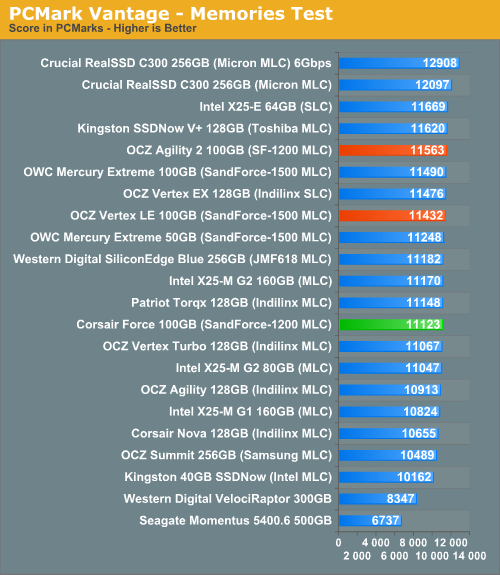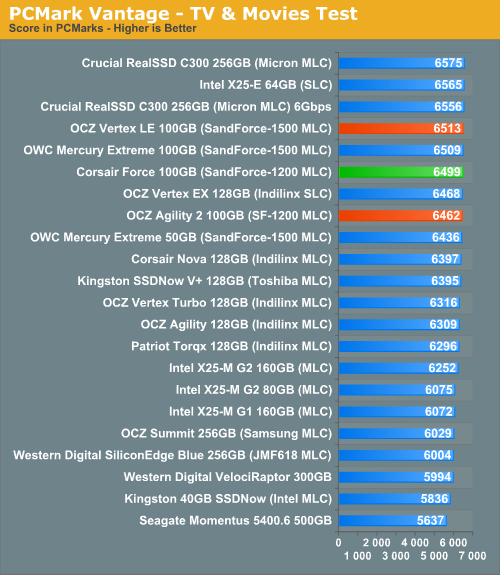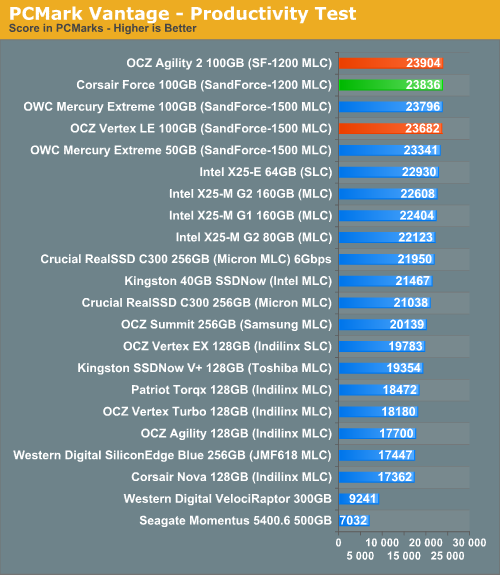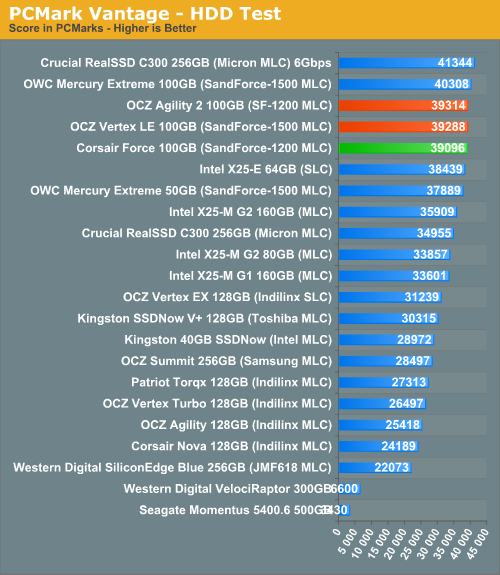OCZ's Agility 2 Reviewed: The First SF-1200 with MP Firmware
by Anand Lal Shimpi on April 21, 2010 7:22 PM ESTOverall System Performance using PCMark Vantage
Next up is PCMark Vantage, another system-wide performance suite. For those of you who aren’t familiar with PCMark Vantage, it ends up being the most real-world-like hard drive test I can come up with. It runs things like application launches, file searches, web browsing, contacts searching, video playback, photo editing and other completely mundane but real-world tasks. I’ve described the benchmark in great detail before but if you’d like to read up on what it does in particular, take a look at Futuremark’s whitepaper on the benchmark; it’s not perfect, but it’s good enough to be a member of a comprehensive storage benchmark suite. Any performance impacts here would most likely be reflected in the real world.

In real world performance the SandForce drives do very well. Crucial and SandForce based drives are the ones to beat. You're looking at around 5%+ performance improvement over Intel's X25-M series and even more compared to Indilinx.
The memories suite includes a test involving importing pictures into Windows Photo Gallery and editing them, a fairly benign task that easily falls into the category of being very influenced by disk performance.

The TV and Movies tests focus on on video transcoding which is mostly CPU bound, but one of the tests involves Windows Media Center which tends to be disk bound.

The gaming tests are very well suited to SSDs since they spend a good portion of their time focusing on reading textures and loading level data. All of the SSDs dominate here, but as you'll see later on in my gaming tests the benefits of an SSD really vary depending on the game. Take these results as a best case scenario of what can happen, not the norm.

In the Music suite the main test is a multitasking scenario: the test simulates surfing the web in IE7, transcoding an audio file and adding music to Windows Media Player (the most disk intensive portion of the test).

The Communications suite is made up of two tests, both involving light multitasking. The first test simulates data encryption/decryption while running message rules in Windows Mail. The second test simulates web surfing (including opening/closing tabs) in IE7, data decryption and running Windows Defender.

I love PCMark's Productivity test; in this test there are four tasks going on at once, searching through Windows contacts, searching through Windows Mail, browsing multiple webpages in IE7 and loading applications. This is as real world of a scenario as you get and it happens to be representative of one of the most frustrating HDD usage models - trying to do multiple things at once. There's nothing more annoying than trying to launch a simple application while you're doing other things in the background and have the load take forever.

The final PCMark Vantage suite is HDD specific and this is where you'll see the biggest differences between the drives:











60 Comments
View All Comments
ogc - Thursday, April 22, 2010 - link
That file 512mb in size which compresses 1000x seems to simply full of zeros, so it represents best case performance for sandforce. On the other hand pure random writes are not expected in typical computer usage so they also are not very meaningful. Any chance to feed iometer with data from your storage bench for example?arehaas - Thursday, April 22, 2010 - link
I actually think random writes with compressed files are meaningful.JPEG files are highly compressed - you can gain only 1-3% by zipping them. Those who work with such files a lot - write to the disk or move around jpegs or similar compressed graphic and video files - should be paying most attention to these new tests for Sandforce. It may be a good idea to add the results for all (most) drives to the page with random writes chart as another chart "Random Writes - Compressed files".
arehaas - Thursday, April 22, 2010 - link
Thanks to the new tests, it appears the charts of rnd or seq writes are currently misleading with respect to Sandforce, if most of your important files (e.g., for a graphic designer) are compressed. The charts are easier to read than text. Currently, one has to flip pages to and from the "Random Data performance page" in order to get the true picture. Maybe Anand can add a bar with "Corsair with compressed data" to the read/write charts? Thanks.davepermen - Thursday, April 22, 2010 - link
I guess that drive is not that well suited for video editing, where you have mostly random data (compressed and uncompressed, both look rather random to the drive). it wouldn't be bad in any way, just lose it's peak performance.FragKrag - Thursday, April 22, 2010 - link
Up until about a week or two ago I was set on an Intel X25-M G2 80GB, but now I'm not so sure anymore. If I got a Vertex 2/Agility 2, it would be a 50GB version... decisions decisions.Oh, and prompted by this article, I looked for the pricing of the Vertex Indilinx on Newegg, and I found this 50GB Vertex LE at $200
http://www.newegg.com/Product/Product.aspx?Item=N8...
never knew they had a 50GB run of Vertex LEs...
willscary - Thursday, April 22, 2010 - link
After my problems last week, I ended up going back to the Crucial M225 series with the Indilinx controller. It is not quite as fast, but it does have a 5 year warranty. I paid $325 for the 128GB drives and a very low $579 for a 256GB drive from Newegg.I have been using these drives in several machines since the beginning of the year. They all support TRIM and I have had no problems. They are very fast in daily use. I had hoped the Sandforce drives would be faster, but I guess I will have to wait for a later date to find out (I will be purchasing another pair of computers in July after the new fiscal year begins...perhaps I will purchase the Sandforce SSDs at that time).
Look09 - Thursday, April 22, 2010 - link
What happens when you use TrueCrypt to encrypt your OS.? Does it then random-write everything and indilinx is better? Does it make the Vertex 2 much better? Or no difference?Ryan Smith - Thursday, April 22, 2010 - link
Encrypted data should look like random noise, and as a result should have very little compressibility. I haven't used TrueCrypt, but it's my understanding that it writes garbage data to whatever part of the hidden partition isn't in use, so the whole thing should largely be uncompressible and match our random data performance.semo - Thursday, April 22, 2010 - link
I'm interested in encrypted testing also. These controllers are beginning to look like very fast consumer drives rather than enterprise (if the SATA interface wasn't a big enough hint already).I'm also wondering why are they getting a more substantial performance hit when writing compressed random 4k writes compared to 2MB sequential writes (74.4% vs 57.4%).
Just to re instate, why are all these SSD makers coming out with SATA drives and calling them enterprise? AFAIK, Intel and Hitachi are working on an SAS SSD but I'm not aware of any other reasonable company doing the same (i'm totally ignoring what the military might have because costs there are nuts).
Mugur - Thursday, April 22, 2010 - link
... Too bad that the price is still high so I'm very interested for the low-end 40 GB ones, but with good random 4k writes. I have 5 machines at home waiting for this upgrade as the boot drive. :-)Allow me to thank you, Anand, for your dedication and work.